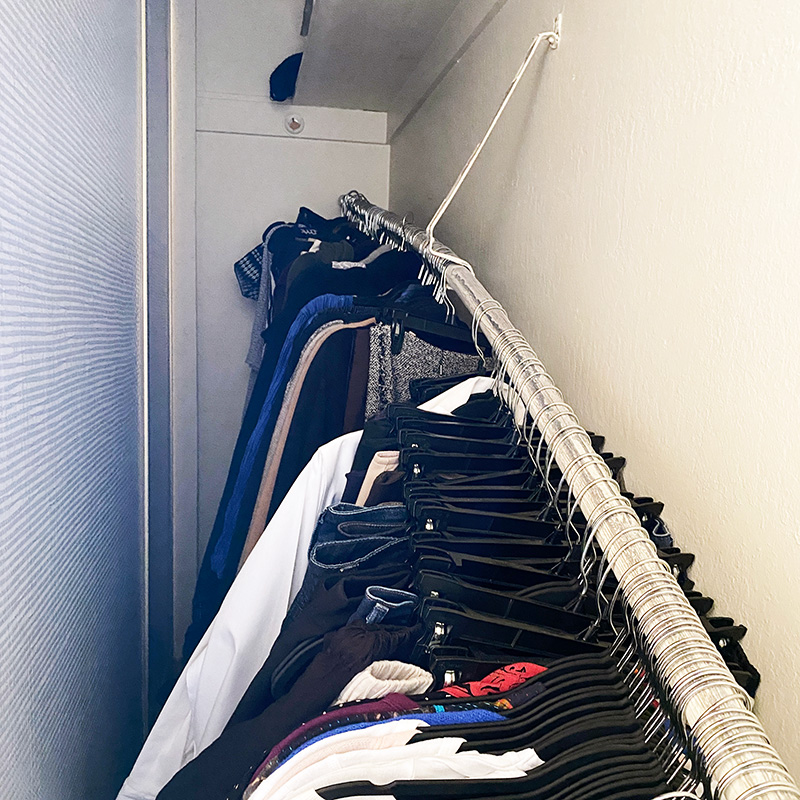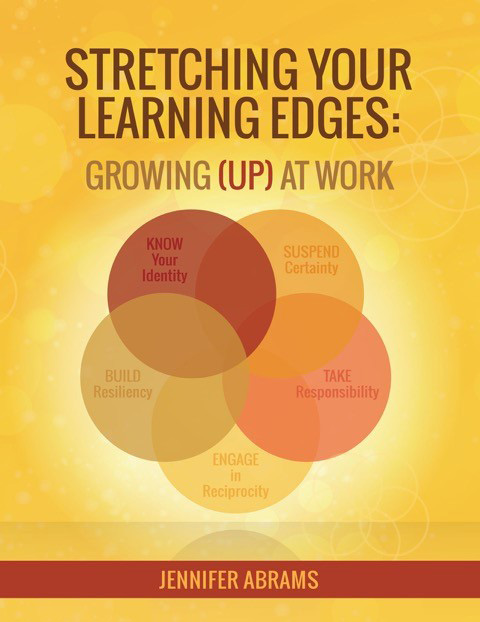Sunk Costs
September 1, 2022

During one of recent my Zoom workshops, I heard a loud, strong thud in my bedroom and when I got a chance to check, I saw nothing. I moved on with my day until I was ready to put my dirty clothes in my laundry bin inside my closet and saw that the entire closet rod had collapsed, as seen in this photo. The whole rod fell onto my shoes and my clothes were in a heap. Huh.
I live in an apartment, and so, could have called maintenance but couldn’t at the time as I was one day into a 5 day quarantine for a positive COVID result. So, I shut the closet door and took a beat. I knew that making lemonade out of a big lemon of an experience could mean I could do a little cleaning, culling the pieces of clothing that I didn’t fit into and getting rid of pieces that were a bit stained. It could become a lemonade of a moment.
Yet as I started to cull, I went into a bit of an internal funk. Look at what didn’t fit anymore! How did menopause widen my waist? And how, now that I have spent money on this clothing, could I give it all away? Sigh. Boo. Ugh.

Ah, the old Sunk Cost Fallacy reared its ugly head. The Decision Lab says, “The Sunk Cost Fallacy describes our tendency to follow through on an endeavor if we have already invested time, effort, or money into it, whether or not the current costs outweigh the benefits.” So I was going to keep clothes I don’t wear, that don’t fit, and aren’t going work for me because darn it, in 2018, I paid good money for them and I am going to keep the clothes whether it makes sense or not!
Kinda silly, given that someone else might really benefit from pants that might fit her or feel good in a warm sweater that is in her color. Would I let my stubbornness get the best of me? Decision Lab says, “The sunk cost fallacy is associated with the commitment bias, where we continue to support our past decisions despite new evidence suggesting that it isn’t the best course of action.” Ah, fallacies and biases….
By this point, you might be thinking, “This isn’t really about Jennifer’s closet is it?” (Reader, you are onto me…) What if it’s about how I am grading when I know that my grading policy isn’t really aligned with what I know to be best for students? What if it’s about my biases toward wanting to teach a certain way because it works for my style and is easier for me when I know it isn’t really helpful for many of my students in my classes? What else am I doing, thinking, or feeling that when I think about it rationally I might need to reconsider or actually give up?
Jane Coaston in her NYT Newsletter, Admitting to Wrongs Makes a Right, says, “Refusing to admit you’re wrong may be intended as self-protection but is really self-deception, which hurts you and your community.”
Yes, I am moving from the micro (my closet) to the macro (our world), and yet that’s how I make sense of things. Did I mess up by buying those pants in 2018? Most likely not, but am I making the wrong choice by being a bit stubborn and saying, “I will lose that weight and I will hold onto them and I will wear them again, darn it.” Probably so. And so, the clothes are going. When I can get out of quarantine, I will bring them all to Good Will. And it’s the right thing to do.
We all sometimes hold onto our past choices even when they aren’t good for our present selves. We need to admit situations have changed and so should our choices and our actions. Join me in the tossing of old pants and old beliefs. See you out in the world post-quarantine and in October!
If you have any questions, comments or topic suggestions, please feel free to email me at jennifer@jenniferabrams.com. I look forward to hearing from you.
Cool Resources
A Repair Kit for Grading: 15 Fixes for Broken Grades by Ken O’Connor
“Communicating about student achievement requires CALM grades- grades that are consistent, accurate, learning-focused and meaningful. To meet these four conditions, educators need to ask several essential questions. To what extent am I confident that students in my school/district receive grades that are consistent, accurate, learning-focused and meaningful? 2. To what extent am I confident that the grades I determine for my students accurately reflect my school/district’s published learning goals and performance standards? 3. To what extent am I confident that what I do in grading is aligned with and contributes to my school/district’s mission, vision and goals? These questions are answered thoroughly and in-depth in this 3rd edition of 15 Fixes for Broken Grades and the Discussion and Repair Guide.”
From Strength to Strength: Finding Success, Happiness, and Deep Purpose in the Second Half of Life by Arthur C. Brooks
“Drawing on social science, philosophy, biography, theology, and eastern wisdom, as well as dozens of interviews with everyday men and women, Brooks shows us that true life success is well within our reach. By refocusing on certain priorities and habits that anyone can learn, such as deep wisdom, detachment from empty rewards, connection and service to others, and spiritual progress, we can set ourselves up for increased happiness.”
The Inner Work of Racial Justice: Healing Ourselves and Transforming Our Communities Through Mindfulness by Rhonda V. Magee
“With warmth, knowledge, and personal storytelling, Rhonda Magee offers us a path to look into the painful truths of structural racial oppression with mindfulness and compassion, which provides the necessary emotional grounding to skillfully work through the pain to generate new solutions through authentic connections to more communities. It may take generations to undo the harms of systemic racial oppression, but with this revolutionary book, Rhonda brings us many generations closer.” — Helen Weng, PhD, Assistant Professor of Psychiatry at the University of California at San Francisco
Unleash Your Complexity Genius: Growing Your Inner Capacity to Lead by Jennifer Garvey Berger & Carolyn Coughlin
“We humans have a natural inclination towards connection, engagement, and creativity – all necessary skills to thrive in complexity. The problem is that the stress caused by uncertainty and ambiguity makes it difficult to tap into this inclination when we need it the most. This book offers a set of practices that help you not only understand complexity but actually hack into your own nervous system to bring your natural capacities back online. By paying close attention to your body, redefining your emotional experiences, and connecting more deeply to others, you can transform the anxiety, exhaustion, and overwhelm that complexity creates.”

